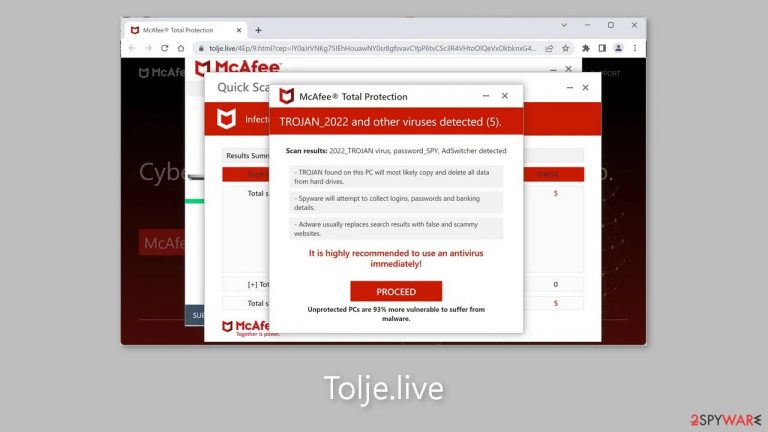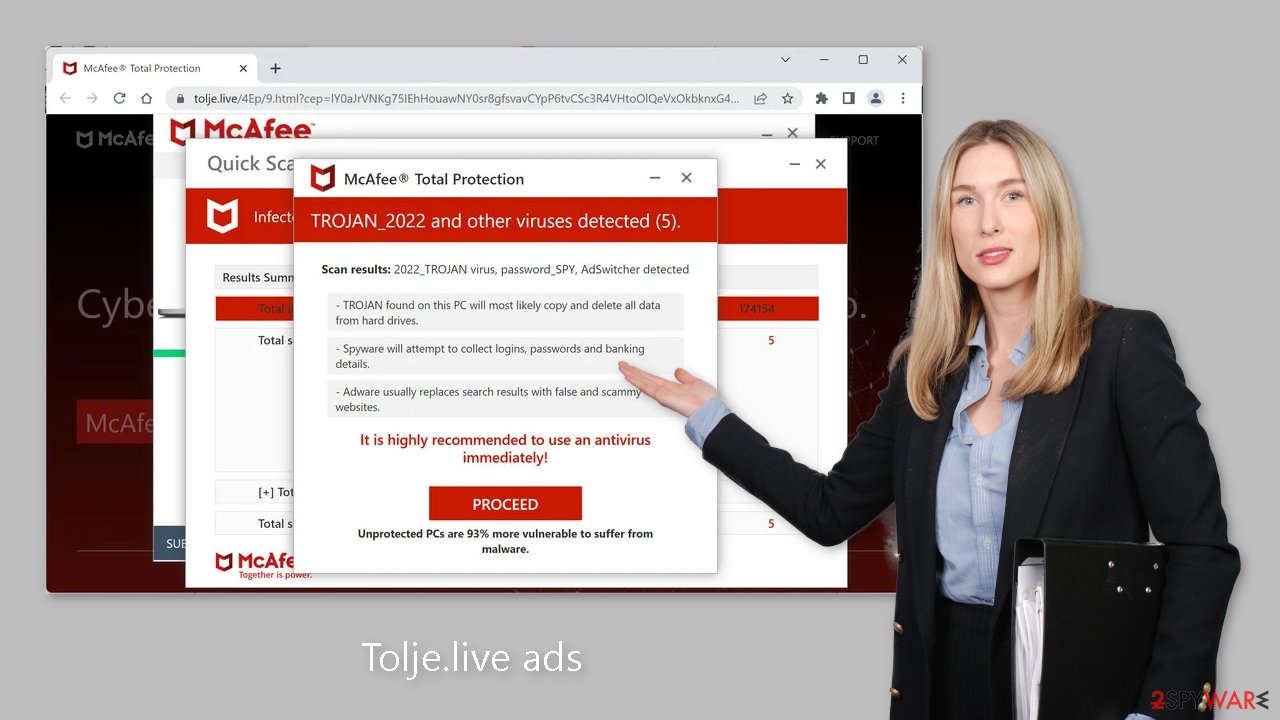Tolje.live ads (fake) - Free Guide
Tolje.live ads Removal Guide
What is Tolje.live ads?
Tolje.live tries to convince people that their PCs are infected by multiple viruses

The website Tolje.live pretends to be the well-known antivirus company McAfee. Crooks created the page in order to make money. To deceive users into believing that their PCs are infected with numerous viruses, they employ social engineering techniques. The website opens with a fake system scan animation that claims there are numerous intruders because the subscription has expired.
In order for fraudsters to profit from the affiliate program, the main objective of the scam is to direct users to the official McAfee website. However, push notifications could also generate a passive income for them. Some claim that as soon as they visited the website, they began to see obnoxious pop-up advertisements.
Rogue ad networks may be used by thieves to place advertisements for risky websites. Users may be tricked into downloading malware and PUPs[1] in an effort to obtain personal information from them. Some users notice advertisements that mimic security alerts.
| NAME | Tolje.live |
| TYPE | Push notification spam; adware |
| SYMPTOMS | A page appears seemingly out of nowhere warning users about virus infections; users may start seeing pop-ups that look like security alerts; |
| DISTRIBUTION | Shady websites; deceptive ads; bundled software |
| DANGERS | People may be tricked into providing personal information, downloading potentially unwanted programs, or even malware |
| ELIMINATION | Disable push notifications in the browser settings; run a system scan with professional security tools |
| FURTHER STEPS | Use FortectIntego to fix any remaining damage and optimize the machine |
What is adware?
Adware[2] infections are frequently to blame for people beginning to see websites like Tolje.live. Pop-ups, banners, and redirects are all examples of commercial content that can be brought on by ad-supported software. Typically, freeware[3] distribution platforms are used to spread it.
They omit a clear disclosure while including extra programs in the installers. It is crucial to pay attention during the installation process because of this. Always select “Custom” or “Advanced” installation options, and make sure you've read the Terms of Use and Privacy Policy. Checking the file list and unticking the boxes next to any unrelated applications is the most crucial step.
For software installations, it is best to use official web stores and developer websites. Apps must go through a thorough review process before being listed on reputable marketplaces. However, you should still conduct research; read customer reviews; consider ratings; and consider the number of users.

Clear the browser from cookies
Small text files known as cookies can store a variety of data, including your IP address, the websites you visit, the links you click, and the products you buy online. They can be used by criminals to generate passive income. Typically, advertising networks or other third parties buy them.
We advise using a maintenance tool like FortectIntego to stop this from happening. Your browsers' cookies and cache can be automatically cleared, which should enhance performance. Additionally, this software can resolve a number of registry problems, BSODs, corrupted files, and system errors.
Turn off fake security alerts
To stop annoying virus alerts from Tolje.live, you have to block the site permissions that allow it to show you push notifications. You can do that by following our step-by-step guide:
Google Chrome (desktop):
- Open Google Chrome browser and go to Menu > Settings.
- Scroll down and click on Advanced.
- Locate the Privacy and security section and pick Site Settings > Notifications.

- Look at the Allow section and look for a suspicious URL.
- Click the three vertical dots next to it and pick Block. This should remove unwanted notifications from Google Chrome.

Google Chrome (Android):
- Open Google Chrome and tap on Settings (three vertical dots).
- Select Notifications.
- Scroll down to Sites section.
- Locate the unwanted URL and toggle the button to the left (Off setting).

Mozilla Firefox:
- Open Mozilla Firefox and go to Menu > Options.
- Click on Privacy & Security section.
- Under Permissions, you should be able to see Notifications. Click Settings button next to it.

- In the Settings – Notification Permissions window, click on the drop-down menu by the URL in question.
- Select Block and then click on Save Changes. This should remove unwanted notifications from Mozilla Firefox.

Safari:
- Click on Safari > Preferences…
- Go to Websites tab and, under General, select Notifications.
- Select the web address in question, click the drop-down menu and select Deny.

MS Edge:
- Open Microsoft Edge, and click the Settings and more button (three horizontal dots) at the top-right of the window.
- Select Settings and then go to Advanced.
- Under Website permissions, pick Manage permissions and select the URL in question.
- Toggle the switch to the left to turn notifications off on Microsoft Edge.

MS Edge (Chromium):
- Open Microsoft Edge, and go to Settings.
- Select Site permissions.
- Go to Notifications on the right.
- Under Allow, you will find the unwanted entry.
- Click on More actions and select Block.

Scan your machine with anti-malware tools
You should run an adware scan on your computer if you disabled push notifications but are still experiencing bothersome symptoms like unexpected redirects and an increase in commercial content like pop-ups and banners. For PUP removal, we advise using the reliable SpyHunter 5Combo Cleaner or Malwarebytes professional security tools. The majority of suspicious apps should be easily detected and eliminated.
Of course, you can remove a PUP manually, but since thieves disguising them as “handy” tools, it is unknown which specific app may be causing annoying behavior. Manual uninstalling a program may also leave some remnants behind, which could lead to the infection returning.
However, if you still do not want to use security tools and know which program is at fault, use the instructions below to help you uninstall it:
Windows 10/8:
- Enter Control Panel into Windows search box and hit Enter or click on the search result.
- Under Programs, select Uninstall a program.

- From the list, find the entry of the suspicious program.
- Right-click on the application and select Uninstall.
- If User Account Control shows up, click Yes.
- Wait till uninstallation process is complete and click OK.

Windows 7/XP:
- Click on Windows Start > Control Panel located on the right pane (if you are Windows XP user, click on Add/Remove Programs).
- In Control Panel, select Programs > Uninstall a program.

- Pick the unwanted application by clicking on it once.
- At the top, click Uninstall/Change.
- In the confirmation prompt, pick Yes.
- Click OK once the removal process is finished.
Mac:
- From the menu bar, select Go > Applications.
- In the Applications folder, look for all related entries.
- Click on the app and drag it to Trash (or right-click and pick Move to Trash)

To fully remove an unwanted app, you need to access Application Support, LaunchAgents, and LaunchDaemons folders and delete relevant files:
- Select Go > Go to Folder.
- Enter /Library/Application Support and click Go or press Enter.
- In the Application Support folder, look for any dubious entries and then delete them.
- Now enter /Library/LaunchAgents and /Library/LaunchDaemons folders the same way and terminate all the related .plist files.

How to prevent from getting adware
Access your website securely from any location
When you work on the domain, site, blog, or different project that requires constant management, content creation, or coding, you may need to connect to the server and content management service more often. The best solution for creating a tighter network could be a dedicated/fixed IP address.
If you make your IP address static and set to your device, you can connect to the CMS from any location and do not create any additional issues for the server or network manager that needs to monitor connections and activities. VPN software providers like Private Internet Access can help you with such settings and offer the option to control the online reputation and manage projects easily from any part of the world.
Recover files after data-affecting malware attacks
While much of the data can be accidentally deleted due to various reasons, malware is one of the main culprits that can cause loss of pictures, documents, videos, and other important files. More serious malware infections lead to significant data loss when your documents, system files, and images get encrypted. In particular, ransomware is is a type of malware that focuses on such functions, so your files become useless without an ability to access them.
Even though there is little to no possibility to recover after file-locking threats, some applications have features for data recovery in the system. In some cases, Data Recovery Pro can also help to recover at least some portion of your data after data-locking virus infection or general cyber infection.
- ^ Potentially unwanted program. Wikipedia, the free encyclopedia.
- ^ Adware. Malwarebytes. Cybersecurity Basics.
- ^ Tim Fisher. What Is Freeware?. Lifewire. Internet, Networking, and Security.
